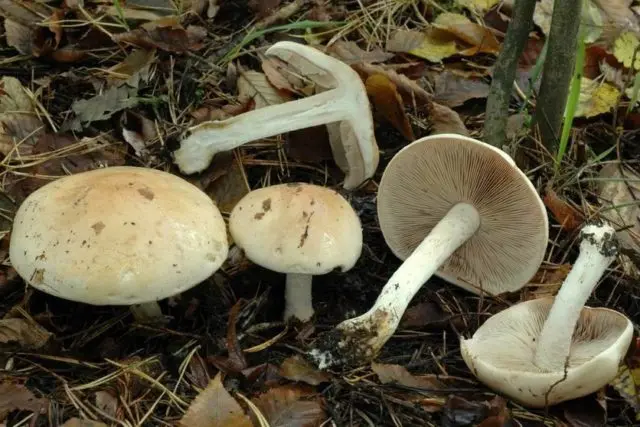Contents
Hebeloma mustard is one of the types of agaric fungi that is part of the Hymenogaster family. It is quite common, so it often occurs between August and November. The fruiting body of this species is classically shaped with a distinct cap and stalk. The official name of the fungus is Hebeloma sinapizans.
What does mustard hebeloma look like?
This species is characterized by a large size and reaches a height of 12-15 cm. The cap of mustard hebeloma has a dense, fleshy texture. Its diameter can vary between 5-15 cm.
In young specimens, it is cone-shaped with curved edges, but as it matures, it becomes prostrate with a clearly defined tubercle in the center. Overripe mushrooms have a characteristic waviness along the edge of the cap. The surface is smooth, shiny, sticky. Its color can vary from cream to reddish-brown. At the same time, it is more saturated in the center, and closer to the edge it becomes lighter.
On the reverse side of the cap are rare plates with a rounded edge. Initially, they have a beige tint, and then become light brown. Spore powder of ocher color.

The pulp of dense structure, fleshy, white. When broken, it does not change its shade, it has a pronounced pungent smell, reminiscent of a radish.
The stem is cylindrical, thickened at the base. Its height is 7-10 cm. At the initial stage of growth, it is dense, and then becomes hollow. Its shade is yellowish white. But in the upper part there are small brown scales, forming an inconspicuous annular pattern.
The spores of this species are elliptical in shape. Their surface is characterized by a rough texture, and the size is 10-14 by 6-8 microns.
Where does hebeloma mustard grow?
This species is found in nature quite often. It can be found in coniferous, birch and mixed forests. In addition, hebeloma mustard grows in glades, park areas, abandoned gardens and meadows, if favorable conditions are created for its growth. It can grow both as individual specimens and in small groups.
In the world of hebeloma mustard grows in the temperate zone of the northern hemisphere. Therefore, it is quite common in European countries. It is also found in North America and Asia. On the territory of Our Country, it can be found in the European part, in the Far East and in Western Siberia.
The fruiting period of hebeloma mustard begins in August and lasts throughout October. With favorable weather, individual specimens can be found in November.
Is it possible to eat hebeloma mustard
This species is considered poisonous, so it should not be eaten. The toxic substances of mustard hebeloma have not been fully studied, but no lethal cases have been recorded.
It is only known that this fungus causes food intoxication, the signs of which appear 2-3 hours after ingestion.
Symptoms of poisoning
When using hebeloma mustard, a person initially feels general malaise, dizziness. Then there are characteristic signs of food poisoning, which are expressed:
- nausea;
- vomiting;
- dry mouth;
- chills;
- pains in the abdomen;
- loose stools;
- elevated temperature.
First aid for poisoning
If you feel unwell, you should immediately call an ambulance. During the waiting period for a doctor, it is necessary to flush the stomach to prevent further absorption of toxins into the blood.
After that, drink activated charcoal at the rate of 1-2 tablets for every 10 kg of weight. It is strictly forbidden to take other medicines, except for absorbents, as this will distort the clinical picture.
Conclusion
Hebeloma mustard is a poisonous mushroom that can be harmful to health. But since it has practically no similar edible counterparts, experienced mushroom pickers do not confuse it with other species.
Poisoning can occur only as a result of inattentive collection or ignorance of the characteristic differences of edible mushrooms.









